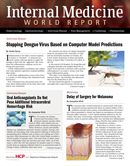Is Pulse Pressure Linked with Neurodegeneration Before Onset of Dementia?
Vascular aging may play a substantial role in the pathogenesis of Alzheimer's disease (AD), and brachial artery pulse pressure is a well-established marker of vascular aging.

Vascular aging may play a substantial role in the pathogenesis of Alzheimer’s disease (AD), and brachial artery pulse pressure is a well-established marker of vascular aging.
A team of investigators led by Daniel Nation, PhD, of the University of Southern California, hypothesized that vascular aging may play a substantial role in the pathogenesis of AD.
Focusing on the potential relationship between pulse pressure and cerebrosopinal fluid (CSF)-based Alzheimer’s disease (AD) biomarker profiles, Nation et al reasoned that vascular aging would be most apparent in the very old (ages 80 to 91) compared with the young old (ages 55 to 79).
They studied 877 participants without dementia (ages 55 to 91) from the Alzheimer’s Disease Neuroimaging Initiative Study, performing baseline health assessments, blood pressure assessments, and lumbar puncture for determination of cerebral spinal fluid phosphorylated tau (P-tau) and ß-amyloid 1-42.
With clinical follow-up between 6 and 96 months, they tracked the progress to dementia in both subgroups of participants. Their results were published online in JAMA Neurology on March 30, 2015.
Pulse pressure was associated with neurodegenerative change prior to the onset of dementia across a broad age range. Among those of more advanced age, higher baseline pulse pressure was also associated with cerebral amyloidosis in the presence of neurodegeneration and a more rapid progression to dementia (95% confidence interval [CI], 1.000-1.048; P = .05; hazard ratio = 1.024).
Systolic pressure exhibited similar relationships with AD biomarkers and progression to dementia in the very old group (P <.05) but showed no associations in the young old group (P > .10). Diastolic pressure was reduced in young old participants with isolated P-tau elevation (P = .04).
The investigators said their findings underscored the importance of the vascular contribution to neurodegeneration in the very old, and suggested a relationship between vascular aging and both tau-mediated neurodegeneration and concomitant cerebral amyloidosis in this population.
They stressed that future studies are necessary to investigate the potential role of reduced cerebral blood flow, increased blood—brain barrier permeability, and reduced clearance of misfolded proteins as potential ways vascular aging is linked to AD pathophysiology.
